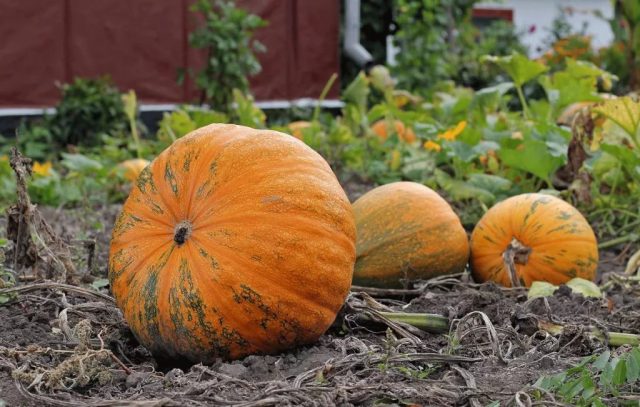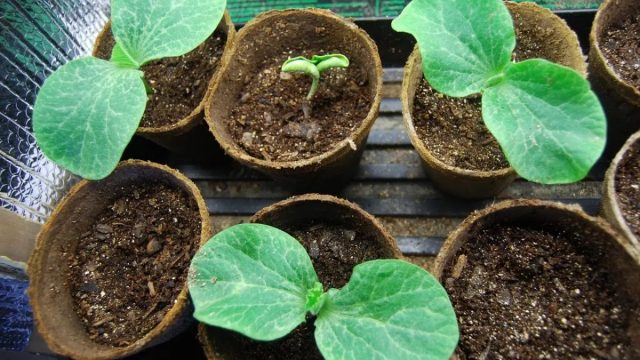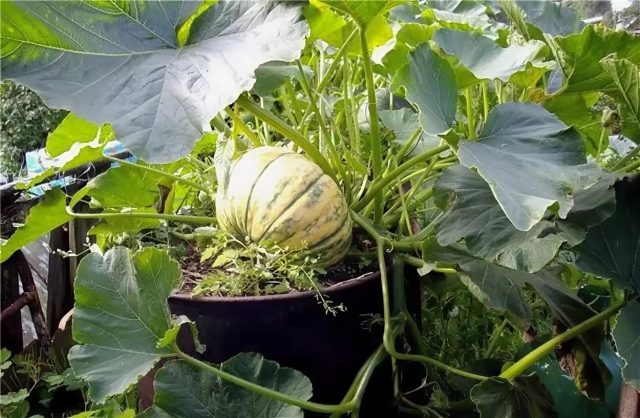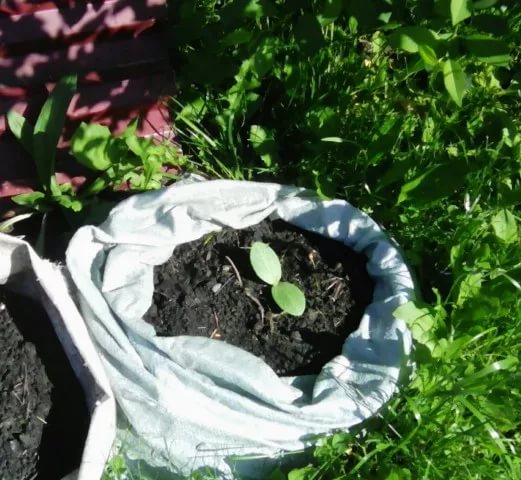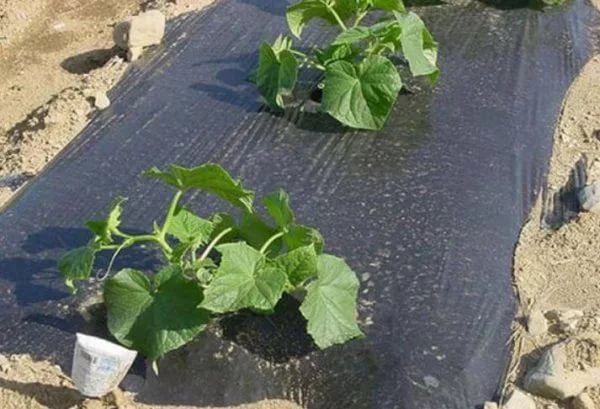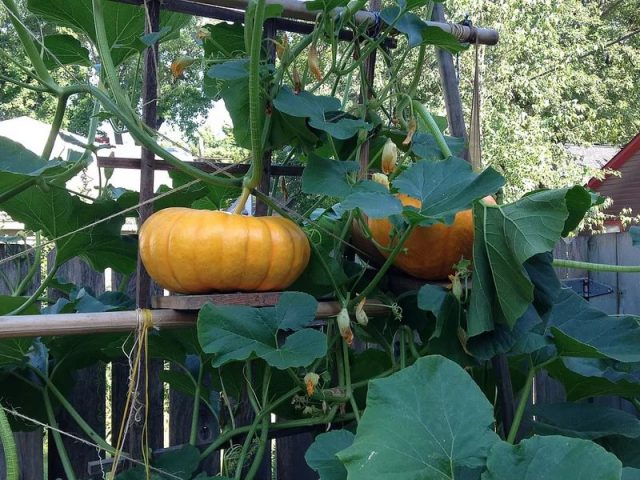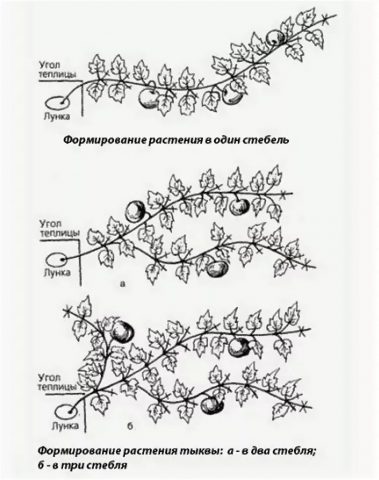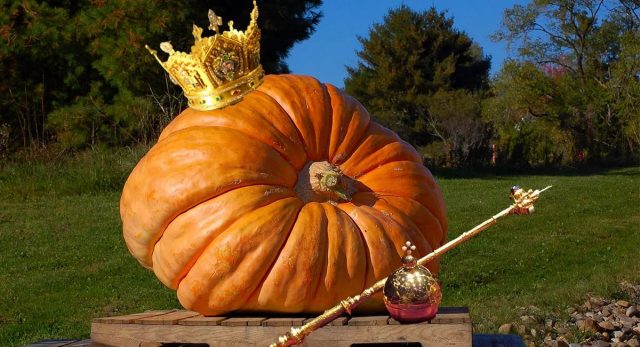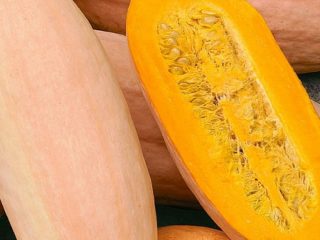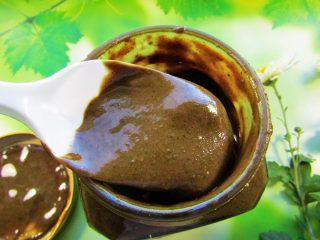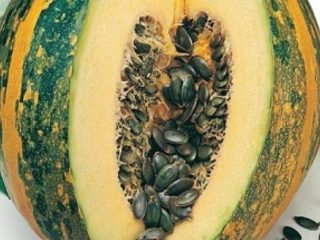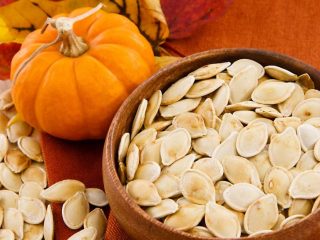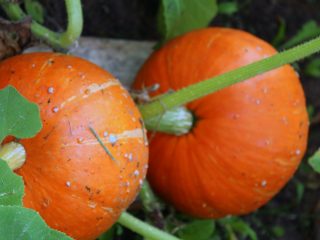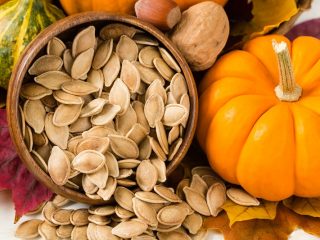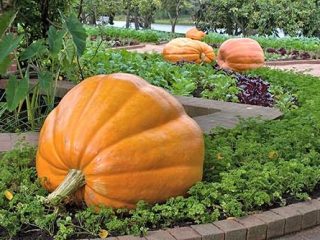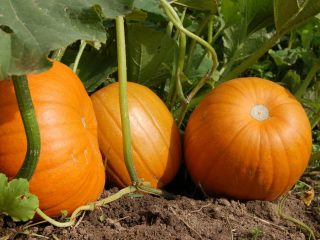Content
- 1 Features of growing pumpkin in different regions
- 2 How to grow pumpkin in open ground
- 2.1 Seedling method
- 2.2 In a barrel
- 2.3 In bags
- 2.4 On insulated beds
- 2.5 Under the film
- 2.6 Is it possible to grow pumpkins on the balcony?
- 2.7 How to grow pumpkin on a compost heap
- 2.8 How to grow a pumpkin in the country on a trellis
- 2.9 How to properly grow pumpkin in trenches
- 2.10 Is it possible to grow pumpkin in a greenhouse?
- 3 How to grow a huge pumpkin
- 4 How to care for pumpkin in open ground
- 5 Conclusion
Pumpkin is a very common garden crop, cultivated not only in the southern regions, but also in the middle zone. It is loved not only for the good taste of the fruit, but also for its unpretentiousness and productivity. Self-care and cultivation of pumpkins in open ground is not difficult, so if there is free space in the garden, it can be allocated specifically for this plant.
Features of growing pumpkin in different regions
Pumpkin grows well in many regions; it is grown not only in the south, but also in Central Russia, the North-West region, Siberia and the Urals. Growing this crop in different climatic regions has its own characteristics. They are connected not only with the selection of zoned varieties, but also with the formation of bushes and rationing of the future harvest.
Moscow region
Growing pumpkins in open ground in the Moscow region has its own characteristics. Cool summers combined with high rainfall, characteristic of this area, do not contribute to high yields. Therefore, in this region it is advisable to choose early and mid-early table varieties for planting, zoned for the middle zone.
For planting, we can recommend, for example, the following hard-barked varieties:
- Mozolevskaya.
- Gribovskaya bush.
- Spaghetti.
- Gymnosperm.
Of the large-fruited pumpkins, the following have proven themselves well in the Moscow region:
- Therapeutic.
- Chit.
- Volga gray.
- Golden cup.
- Big Moon.
You can also grow nutmeg pumpkin in the Moscow region. These varieties include:
- Nutmeg.
- T-7.
- Candied.
To make the most of the summer heat, pumpkins are grown in open ground using seedlings. The formation of a bush also has its own characteristics. In order for full-sized fruits to form on the plant, the vines are pinched, limiting their growth, and the number of fruit ovaries on each bush is normalized. Typically, pumpkins in the Moscow region are formed into 1 main and 1 side stem. At the same time, 2 fruits are left on the main vine, and 1 on the side vine. The bush simply will not have time to feed more. To improve the taste of the fruit, stop watering the bushes a week before harvesting, otherwise the pumpkin will taste watery and will not store well.
In the Urals
Pumpkin cultivation in the Urals in open ground is carried out using seedlings. The climate of this region is characterized by short and cool summers. Here you need to be especially careful when choosing a variety and following agricultural practices. Preference should be given to species with early ripening, such as:
- Sweetie.
- Dacha.
- Bush gold.
It is the bush varieties of pumpkin that are preferable to grow in open ground in the Urals, since the long climbing stems are more susceptible to the influence of adverse weather conditions. One main shoot and one side shoot are usually formed on the bush, leaving 1-2 fruit ovaries on each.
In Siberia
Growing pumpkin in Siberia in open ground is possible thanks to the breeding of early ripening varieties, such as:
- Freckle.
- Smile.
- Adagio.
- Russian.
- Pearl.
All these varieties are early and have a ripening period of about 90-110 days. In the short, hot Siberian summer, they have time to fully ripen. The dry climate of this region with little rainfall has a beneficial effect on the growth of this crop, since it does not like excessive humidity.
In Siberia, melons are usually formed into one stem, leaving 1-2 fruit ovaries on it for accelerated ripening. Bush forms are pinched, removing excess shoots and normalizing the future harvest.
In the Leningrad region
The north-west of Russia, which includes the Leningrad region, has an unstable climate. Late spring here gives way to a rainy, cool summer and a long, cold autumn. The air temperature strongly depends on the wind rose and can vary significantly during the day. Despite the unfavorable climate, growing pumpkins in the Leningrad region is possible even in open ground.
For planting in this region, it is recommended to use early ripening varieties with increased resistance to unfavorable climate. These include:
- Almond 35.
- Acorn.
- Bush orange.
When growing pumpkins in open ground in the Leningrad region, the seedling method is used, and the choice of planting site and proper agricultural technology will also play an important role.
How to grow pumpkin in open ground
Growing pumpkins in open ground and caring for them is not difficult, but requires compliance with certain rules. Pumpkin loves warmth and sun, as well as fertile soil. In the southern regions of the country, all conditions for the normal growth of this crop are available. Planting is done by seeds. Further care for the pumpkin is carried out in minimal quantities. However, in regions with an unfavorable climate, this approach will lead to the fact that the harvest will be small or will not ripen at all. Therefore, in more northern regions, the seedling method of cultivation is used, while reducing the period the plant spends in open ground.
Seedling method
The average period of pumpkin growing season from the emergence of seedlings to harvest is 120-140 days. In many regions of the country, the warm season lasts a much shorter period of time, so it is simply impossible to carry out the full cycle of cultivation in open ground from planting to harvest. Pumpkin seeds are first germinated at home, and after suitable weather is transplanted into open ground.
Individual peat cups are best suited for growing seedlings. Their use allows you to avoid picking - the procedure of planting young plants, which is very stressful for them. By using individual peat cups, the ripening time of pumpkin is reduced by 3-5 days, which is also important when growing it in open ground.
Preparing pumpkin seeds before planting usually consists of 3 stages:
- Warm up Seeds selected for planting are immersed in hot (+ 45 ° C) water for 1.5-2 hours.
- Germination. The seeds are wrapped in damp cloth or gauze and kept until they hatch.This usually takes 3-3 days.
- Hardening. The hatched seeds are placed in the refrigerator for 3-5 days. This increases resistance to cold and temperature fluctuations.
After all the procedures have been carried out, the seeds are planted in peat pots filled with nutrient soil to a depth of 3-6 cm. The soil can be purchased at a specialized store or prepared independently by mixing peat, humus and river sand in equal proportions. Planting pumpkin seeds for seedlings is carried out approximately 3 weeks before the planned transplantation of plants into open ground. After planting the seeds, the pots are covered with a transparent film, which is periodically removed for ventilation. After germination, it is better to keep the seedlings on the windowsill on the south side of the house. Periodically, the soil must be moistened. After 2-3 full-fledged (not cotyledon) leaves appear on the plants, the seedlings are transplanted into open ground.
In a barrel
Amateur gardeners have come up with many ways to grow pumpkins, in addition to traditional ones. First of all, this concerns the use of various designs and materials that appear in everyday life. One such method is growing pumpkin in a barrel. This method is relevant for owners of small garden plots, as it can significantly save space for other plantings. For such an improvised garden bed, a used metal barrel, ideally without a bottom, is suitable.
The old container should be placed in a well-lit place, since the pumpkin will not grow in the shade. After this, they set up a kind of warm bed. The barrel is filled in layers, first with large organic matter (branches, large roots), then tops, leaves, grass.It is best to pour a layer of compost mixed with turf soil on top. The contents of the barrel must be compacted well. The bottom and walls must be perforated to provide the roots with air exchange and removal of excess moisture. A month before the planned planting, such a bed should be shed with warm water, and then with a solution of any preparation containing effective microorganisms (EM preparations). Bacteria will begin to intensively decompose organic matter, enriching the soil with nutrients.
At the end of May or beginning of June, 1 or 2 cups of seedlings are planted in a barrel. If by this time the contents of the container have settled significantly, it is necessary to fill it to the top with earth mixed with humus. Planted pots with seedlings are watered; you can also cover the plants with cut containers made of transparent plastic if night temperatures drop to low values. As the pumpkin grows, its stems begin to droop. After setting 2-3 fruits, the stems are pinched. To prevent ripening pumpkins from tearing off under their own weight, they are tied up with nets or supports are installed. After harvesting, the used soil can be scattered around the site or added to the beds along with digging.
In bags
Growing pumpkins in bags is carried out using the same technology as in barrels. In this case, the container for the nutrient soil is an old metal container, but black plastic garbage bags with a capacity of 100 liters. They are strong enough to support the weight of the soil along with the plant, but they must be filled with components on site. It will be quite difficult to move bags of soil around the site without causing damage.
An undoubted advantage of growing pumpkins, both in barrels and in bags, is the saving of space on the site due to the vertical growth of the stems. In addition, such plantings do not require weeding. The container with soil serves as a kind of thermal accumulator, which heats up during the day and slowly releases heat to the plant at night. This is very important when growing this crop in the northern regions.
Educational video about growing pumpkins and other vegetables in bags:
On insulated beds
Insulated beds are installed in open ground relatively rarely. Usually they are preferred to be done in greenhouses for growing cucumbers or tomatoes. However, this does not mean that such a bed cannot be made for pumpkins. This design is a kind of multi-layer cake. Large wood waste is placed at the very bottom: chopped branches, roots. A layer of smaller waste, sawdust, and wood shavings is poured above. Next comes a layer of material that can quickly turn into compost: tops, weeds, dry grass. Finally, a layer of nutritious soil from a mixture of turf soil and humus is poured on top.
The thickness of such a layer cake can be 0.6-0.8 m, so such beds are usually made with deepening. The layer of wood waste serves as good thermal insulation, which is why such beds are also called “warm”.
Under the film
Often, beds where pumpkins or other heat-loving crops are grown are covered with black film. This solves several problems at once:
- The growth of weeds stops and there is no need for weeding.
- The beds heat up quickly and retain heat for a long time.
- Excess moisture does not get into the soil.
To plant seedlings, small cuts are made on the film in the right places.
Is it possible to grow pumpkins on the balcony?
Growing pumpkins on the balcony can be done both for decorative purposes and for harvesting. Any small-fruited varieties are suitable for this, such as:
- Orange.
- Baby Boo.
- Sweet Dumpling.
Such pumpkins grow well not only in open ground, but also in containers that can be mounted on balcony railings. Planting can be done with both seeds and seedlings. Care procedures are not much different from ordinary ones; plantings need to be watered and the soil periodically loosened. Climbing varieties can be used to create a green hedge; for this, you can stretch vertical ropes along which the pumpkin stem will grow.
How to grow pumpkin on a compost heap
A compost heap is analogous to an insulated bed, so it is quite possible to grow a pumpkin on it. To do this, it is enough to pour 15-20 cm of good fertile soil on top of the container with the compostable mass, into which the planting will take place. You can plant both bush and climbing varieties, if the location of the compost heap allows. There are no differences in the agricultural technology of growing pumpkins in this way; all basic activities (watering, pinching shoots, weeding) are carried out in full for such plantings.
How to grow a pumpkin in the country on a trellis
To save space in your garden plot, you can use the method of growing pumpkins on a trellis. The branched stems have tendrils that perfectly hold onto a wire stretched at a height of 1-2 m.This method is good because the fruits ripen by weight and are perfectly smooth. In addition, pumpkins do not have contact with the ground, so the risk of pest damage in this case is minimal.
When growing a pumpkin on a trellis, the plant is formed into 2 shoots (1 main and 1 side), sending them in different directions. The number of fruit ovaries is normalized; 2 pumpkins are usually left on the main stem, 1 on the side stem. The trellis must be strong enough to support the weight of the fruit. To prevent the pumpkins from tearing off under their own weight, they are placed in fabric bags or nets that are tied to the top support.
How to properly grow pumpkin in trenches
The trench method of growing pumpkins was proposed by Galina Kizima, a gardener from the Leningrad region, who devoted many years to growing various crops at her summer cottage. In her book “Vegetable Garden Without Hassle,” this method is described in great detail. The technology for growing pumpkins in open ground according to G. Kizima’s method is as follows:
- In the fall, trenches 2 spade bayonets deep are dug in places where pumpkins will be planted.
- Compost, rotted manure, and plant residues are placed in the trenches.
- In the spring, after the snow melts, the trenches are covered with a layer of fertile soil.
- The trench is covered with black film.
- After about 10 days, when the soil warms up to 15-16 °C, the seeds are planted.
- When the shoots appear, the film over them must be carefully cut through.
The film is not removed from the ground all summer. Such a bed does not require watering or fertilizing; a small amount of water can be added only in the hottest time and during the period of intensive growth.This method allows you to grow a good pumpkin harvest even in the northern regions.
Is it possible to grow pumpkin in a greenhouse?
Some gardeners use an original way to grow pumpkins in a cucumber greenhouse without taking up space in it. To do this, 2 pumpkin bushes are planted on the south side of the greenhouse close to the wall. After the stem reaches the required length, it is removed from the greenhouse, and then it begins to grow in the exhaust gas. The roots remain in the greenhouse.
This method is good because it allows you to plant seedlings or seeds much earlier than usual. Care for the root zone is carried out in the greenhouse, along with other crops. The plant is formed into 1, 2 or 3 stems, depending on the growing conditions.
How to grow a huge pumpkin
The officially recorded record weight of 1 pumpkin is 1190 kg. Mathias Willemains from Belgium managed to grow such a giant fruit in 2016. Specimens weighing several hundred kilograms are far from uncommon; many countries even hold championships for growing pumpkins of record weight.
To grow a large pumpkin in the country, you need not only a good climate and fertile soil. It is important to choose a fast-growing, large-fruited variety. Plantings require a lot of open space and sun. The plant should be well cared for, including regular fertilizing with easily digestible fertilizers. To get a large fruit, the plant must be formed into 1 stem and only 1 pumpkin left on it. After this, all excess shoots are removed and the growth point is pinched.
How to care for pumpkin in open ground
Caring for pumpkins in open ground is not difficult. Several times a season, the plant is fed with an aqueous solution of slurry or bird droppings.You can also use complex mineral fertilizers dissolved in water. The frequency and amount of watering depends on the region and growing method. Some methods even provide for the possibility of abandoning this procedure. A few weeks before harvest, all watering is completely stopped, otherwise the shelf life of such a pumpkin will be short.
Depending on the climatic conditions and the area where the pumpkin is grown, it is formed into 1, 2 or 3 stems, leaving from 1 to 4 fruit ovaries on 1 bush. This allows you to normalize the harvest and make it larger.
Conclusion
Caring for and growing pumpkins in open ground can be done by anyone, even the most inexperienced gardener. The activities are not complicated, and some methods, after certain preparatory measures, do not require any human intervention at all. At the same time, it is possible to grow a good harvest even in areas with an unfavorable climate, which is far from ideal for growing pumpkin.
